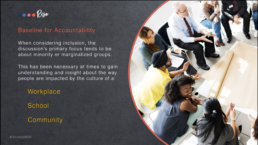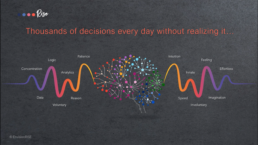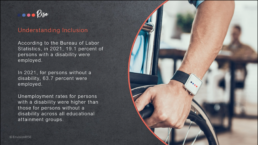The Evolution of Mission, Vision and Values
The Evolution of Mission, Vision and Values
By Staci Hegarty, M.Ed.
We often treat our organizations’ mission, vision, and values as immovable bedrock. In many ways, they are. Yet as the world changes, we must consider that we may need to adjust or expand the goals and aims of our business.
Evolving Envision RISE
This even happens to organizations like Envision RISE, a company that prides itself on offering leading services and training to assist in organizational change and transformation. Founded by IpX, the Institute for Process Excellence, a leader in enterprise transformation, RISE was launched to provide organizational change management (OCM) primarily through the lens of diversity, equity and inclusion (DEI). Since 2020, our customer’s found the most success when our partnership kept the lens opened to support all types of organizational change. Of which, successful DEI can become a byproduct of improving legacy policies and procedures along with focused goals and objectives.
Our values have not changed, we believe that companies succeed when their people succeed. That means creating a workplace where all voices are valued, and differences are embraced. Yet the world has changed. The words “diversity, equity, and inclusion” have become a distraction from the core work of centering and uplifting people in the workplace.
Realigning Company Values for Success
Before you start revising anything, it is critical that leaders agree on their values. Not their personal value system, although that will have an impact, but the values of the company. Your values may expand or transform over time. For instance, many companies did not include sustainability as a company value even a few years ago. Now many organizations have begun to prioritize sustainability in their daily operations. The important thing is to verbalize those values in a way that people can understand and support.
Look at your mission statement. Whether it was written one year ago or one hundred years ago, it may need to be updated to better align with your strategic plan. If you need some ideas, this Hubspot blog can get you started.
Your vision statement is about the future, while taking the current state into consideration. Your vision statement will help to guide your strategic plan. If your vision statement doesn’t include your people, your strategic plan will fall short.
You don’t have to do this alone. The experts at Envision RISE can help your leadership team clearly identify the mission, vision, and values of organization through a variety of services, including executive and leadership alignments, assessments, and focus groups.
Going Beyond the Survey: Creating Holistic Change from Survey Results
Going Beyond the Survey: Creating Holistic Change from Survey Results
Envision RISE
Employee surveys continue to be an invaluable source to organizations. They provide numerous benefits, including measuring employee engagement, assessing employee satisfaction, and collecting feedback. But not all organizations are harnessing the benefits of employee survey data. Many organizations collect survey data but are unsure what steps to take next.
So, you administered an employee-wide survey and collected data on the health of your organization. Now what? If your organization has been sitting on survey results for months, with little to no action, you are not alone. Surveys are undertaken with good intentions, with the hope of understanding the needs and concerns of the workforce. Once the results are in, it can be overwhelming to analyze the data and then prioritize and act on the results. Oftentimes the results are compiled without a plan for action. Without a clear action plan, implementation will either not happen at all, or it will be counterproductive, leaving things worse than they were.
When an outside source administers an employee survey, they should provide you with results as well as insights into the data that may not be obvious from the results alone. Were there themes in the answers from a particular demographic or department? Are all of your employees having a similar experience, or are certain groups having vastly different experiences? An effective organizational consultant turns survey data into real-life narratives about the experiences of its employees.
Effective consultants also convert employee survey results into actionable plans. They provide you with a summary of risks and recommendations. If a third party consultant doesn’t offer strategic planning as part of their expertise, your organization will need to be diligent in ensuring that needs are highlighted, prioritized, and included in budgeting and long-term planning. (Pro tip: think twice before hiring a company that does not provide insights, recommendations, and assistance in developing a roadmap for transformation!)
Whether your survey is done internally or through a third-party, your plan before, during and after implementation should include the following:
A Messaging Plan
Don’t just send out a link to the employee survey and hope people will participate. Motivate your workforce to participate by communicating to them about WHY their input is important and what will be done with the information.
Once the survey is complete, decide how you will share the results. Sending detailed data results to the entire workforce is often ineffective. We recommend promoting workforce engagement by providing employees with a summary of the results, along with a plan for action. Your messaging should outline the next steps and inform your workforce the actions that will be taken.
Expert Advice Following the Employee Survey
The results of your employee survey may illuminate a need for services or training that are not currently part of your existing expertise. Consider bringing in experts to transform your survey data into effective organizational change. If your budget currently does not allow for third party training, it may be time to reconsider how your organization views workforce training. Training your workforce has countless benefits and should be seen as an investment, rather than a cost. Many experts can work within a limited budget, so it helps to be transparent about what your company can afford.
Collect Qualitative Data from Stakeholders
Collecting post-survey qualitative data can be a great way to provide context to survey results. Consider holding focus groups to gain a deeper understanding of employee experiences. Individual interviews can also provide insights into organizational culture and employee resistance to change. It is unusual for everyone to share the same enthusiasm or dedication to particular initiatives. Qualitative data collection can be a way to understand what may contribute to employee resistance to change and what steps might be taken to motivate employees to be engaged in the change process.
Executive Alignment Following the Employee Survey
Successful organizational change begins at the top. Change happens when leaders work collaboratively to attain organizational goals. With the survey results, risk, and recommendations in hand, bring the executive leadership team together to forge an actionable plan. Leaders should collaborate to create a shared vision, success criteria, and an ongoing training and monitoring plan.
Progress Measurements and Adaptive Monitoring
How will your organization know when it is making progress? What does success look like? Do not wait until the next annual survey to find out if your plan is having the impact you intended! Effective action plans include a method for measuring progress. Be sure to include quantitative metrics whenever possible. If any action items are more difficult to quantify, determine how progress will be measured. Then, collect and assess data regularly throughout the change process to measure progress and revise action plans if necessary.
Organizational transformation requires work. It does not happen through good intentions and hope alone. Envision RISE can assist with setting a course for your transformation journey, beginning right where you are at this moment. From baseline assessments to executive alignment to strategic planning to training, we have the expertise to help you plan and execute an effective organizational transformation.
References
https://www.driveresearch.com/market-research-company-blog/10-benefits-of-employee-surveys/
https://www.surveymonkey.com/curiosity/storytelling-with-data/
https://www.linkedin.com/pulse/alignment-leadership-successful-change-management-nikita-shah/
The Workforce Beyond Boomers
The Workforce Beyond Baby Boomers
Staci Hegarty, M.Ed, VP of Equity and Inclusion
2030 is the year all Baby Boomers (born 1946-1964) will be at or above the traditional retirement age of 65. Although many Boomers work well past that age, there will be more open roles within organizations that cannot be filled by the next generation of workers. Combine this with the Great Resignation, employers are finding themselves in the difficult position of not being able to find enough qualified workers.
What Does the Future of the Workforce Look Like?
Organizations are not only losing the employee, they are also losing historical knowledge and the skillsets that come with time spent on the job. On average, Boomers are most likely to spend more years with the same employer than the other generations. The average Boomer has a workplace tenure of over eight years, with several studies indicating that nearly 40% have been with their employer for 20+ years. Gen X (born 1965-1979) averages about 5 years, while Millenials (born 1980-1994) and Gen Z (born 1995-2012) both average less than three years.
The younger generations are quick to leave an organization that does not value their time, talents, and insights, and with so many open roles, they are able to find new opportunities relatively quickly. Employee attrition can destroy a company by derailing the strategic plan, stifling innovation, and driving up costs related to human resources and recruiting. We are already in a hiring crisis and employers must take tangible and impactful action to retain and promote the workers they already have.
How Do We Support the Next Generations?
The old mindset of employee retention no longer works. A fair salary is an obvious requirement to attract a retain employees, but that alone will not be enough to prevent an employee from leaving. The culture of the company is the most important thing to workers. Job security, work/life balance, connections with coworkers and flexibility – in not only work schedule but in workplace (home versus in-office) – are the top four drivers of employee satisfaction. Organizational Change Management (OCM) in partnership with Diversity, Equity, and Inclusion (DE&I) work will allow companies to transform the existing workplace culture from “good enough for now” to dynamic, empowered, and innovative.
Envision RISE offers a comprehensive approach to help companies build a dynamic and empowered workplace culture that is prepared and adaptable. Through surveys, focus groups, executive alignment, and policy review, Envision RISE can help companies understand their employees’ sentiment, identify areas of improvement, and develop a roadmap for continual improvement. This approach is crucial for creating a workplace culture that not only retains employees but also drives innovation and growth.
Contact us to get started. Listen in to the most recent Envision RISE Podcast featuring Martine Kalaw, founder of Martine Kalaw Enterprises and author of “ABCs of Diversity,” as we discuss the generational changes actively happening and how they are reshaping the future of the workforce.

Unlocking Employee Retention: Strategies for the Challenging Labor Market
Unlocking Employee Retention: Strategies for the Challenging Labor Market
Staci Hegarty, M.Ed, VP of Equity and Inclusion
In the United States, a common complaint is that “no one wants to work,” even though we are currently experiencing a period of the lowest unemployment in the past 50 years. This, coupled with the fact that all Baby Boomers are rapidly reaching traditional retirement age by the year 2030, means we are in a difficult position of having more open roles than we have available workers.
In this environment, employee retention has become a top priority for companies, particularly amid “The Great Resignation.” Envision RISE course RISE-08 “Transparent Development and Retention Practices” states, “Healthy, high-performing organizations have the policies and procedures in place to uncover problems before it costs them high-potential employees. Once employees start resigning, the reputation of the company is at risk.”
Retaining Current Talent
Rather than competing for qualified candidates, organizations are taking steps to retain the ones they already have. The days of a steady paycheck being enough are long gone. Employees now seek fair and equitable pay, benefits that meet their needs, and a workplace culture that values what each person brings to the job, as well as inclusion and a sense of belonging.
Unfortunately, many employers dismiss these desires as passing fads or entitlement. However, research indicates that employees who feel a greater sense of belonging and inclusion at work report a significantly higher Employer Net Promoter Score (eNPS), which measures the likelihood that a current employee would recommend a company as a great place to work. This metric can provide insights into company culture, predict turnover, and gauge overall employee engagement.
How to Measure Inclusion and Belonging
Here are a few ways to start measuring inclusion and belonging at your organization:
- Start by examining who is in your workforce. Who gets hired and who stays?
- Provide thoughtful exit interviews. What do they tell you?
- Consider using “Stay Interviews.” Stay Interviews identify trends that could be contributing to employee turnover. By prioritizing employee retention and cultivating an inclusive workplace culture, companies can thrive in this challenging labor market.
Overall, companies must invest in employee retention if they want to remain competitive and profitable. A steady paycheck may have been enough in the past, but today’s employees seek much more than that. Fair pay, appropriate benefits, and inclusive workplace culture are essential components to successful employee retention. Ultimately, it’s up to employers to earn the loyalty of their current employees by creating a work environment that meets employee expectations and shares in the companies’ successes. Ensuring that all employees feel valued, respected, and part of a greater whole will help any organization stay competitive. For guidance on how best to meet these goals, contact Envision RISE for employee retention services and strategies tailored to your needs.
New Year, New Work/Life Balance
New Year, New Work/Life Balance: 6 Ways to Create, Apply, and Measure a Work/Life Balance
Staci Hegarty, M.Ed, VP of Equity and Inclusion
Achieving better work/life balance is a common, and meaningful, New Year’s resolution, especially if you are a remote or hybrid worker. Many of us have undoubtedly found ourselves still sitting at our desks, dinner in hand, or having a prolonged night at the office beyond the standard quitting time. It is a worthy goal with usually unclear steps or structure to achievement. If this is a goal you have set for yourself in 2023, it’s important to determine a few things:
1. Your definition of work/life balance. It’s difficult to achieve what you cannot visualize. Would that mean working fewer hours? Working different hours? Having fewer tasks or responsibilities in certain areas of your life?
2. The root cause for why you feel out of balance. For example, have your working conditions changed as the results of a new role, staffing issues, new leadership, or a temporary high-priority project that is taking up more of your time? Perhaps there are changes in your personal life, such as a new baby, an illness, or a change in family income. Even a new pet can add additional responsibilities and cause a change to your routine.
3. What boundaries need to be set at work and at home. Most of us struggle with saying “no.’ In some workplace cultures, the word “no” is interpreted as not being a team player or dedicated employee. At home, it may be even more challenging to say “no” to the needs of our family/friends.
4. Where your needs fall on your list of priorities. We may find it difficult to take care of ourselves when we perceive that we are needed by others. It doesn’t take very long to find ourselves trying to pour from an empty cup, then criticizing ourselves for not being good enough when we feel tired, burnt out, or resentful.
5. How to know when work/life balance is achieved. This is a difficult goal to quantify, unlike weight loss or increased exercise or other popular resolutions. We know what imbalance feels like, but we may not truly know what balance feels like.
6. How to adjust your expectations. It is unlikely that you will achieve equality in how you distribute your time between your professional and personal life. Aim for equity, where each part of your life gets what it needs to thrive.
In Envision RISE training, course RISE-06 Harmonization: Demystifying the Entanglement between Work and Life shares:
‘Balance implies that things will become equal, which is not truly what we are attempting. We only have one life. Why would we think we can have a work life that is separate from our home life? We would be better served to find ways to harmonize all parts of our lives with one another, allowing for each to take center stage as needed, and then step back into the chorus when the time comes.’
With a little self-reflection and a willingness to create and enforce boundaries, our lives can become more manageable, more fulfilling, and less chaotic. No one can do this for us, we must be willing to do it ourselves.
For support on creating balance and managing organizational changes in the workspace, contact us at Envision RISE. We work to create a powerful integration and understanding of the relationship between your organization and your workforce.
Promoting a Culture of Calm During Chaos
Staci Hegarty, Envision RISE, Vice President of Equity & Inclusion
We are more than two years into the most intense period of change that most of us have ever experienced in the workplace, and for some of us, in our lifetime. After the initial shock, many organizations managed to adapt to life during COVID. Theses adaptations were far from perfect, and we are still working through it and learning from it. There is civil unrest across the US, which will not abate any time soon. The economy is teetering on the brink of recession, with inflation at a 40-year high and gasoline hitting record prices. The “Great Resignation” coupled with low unemployment pushed staffing levels to the breaking point. Many organizations are struggling to find their center. Those that have taken promoting a culture of calm during chaos seriously have been better able to weather the storms.
We are not our best selves right now.
And yet, we have done some of our best change management over the past couple of years. We were so confident in what we believed to be true for so long that we rarely questioned it. When forced to question almost everything, look what we discovered! We can be flexible in our work locations and still get results. We can engage in uncomfortable conversations about topics we were always told were off limits at work, which allows us to learn more about ourselves and our colleagues. The economic issues we experience are not in a vacuum; we are an inextricably connected global economy. Finally, we can demand better from our workplace cultures, or we can find a better workplace.
For those waiting to “return to normal,” I have bad news for you. There is no going back. The last few years exposed many truths about our workplaces and how we are affected by that culture. Crisis shows us our true selves.
Amid chaos, what was the prevailing emotion at your company? Did you find out that your organization is much more fragile than you realized? Or did you uncover innovation and resilience that was just beneath the surface of everyday life?
Understand more about your company by understanding its DNA. Your company’s DNA structures the ecosystem framework. Upon this framework is built the foundation for your culture throughout the employee lifecycle. When the DNA is fragmented, broken, or otherwise unstable, it creates an imbalance that compromises the health of the organization. Unhealthy organizations struggle to overcome the stress of change, especially unexpected change. The RISE Human Resources Management (HRM) DNA analysis helps identify the areas that need attention and strengthening. Combine the HRM DNA analysis with the Envision RISE comprehensive cultural assessment to create an actionable strategic plan for lasting organizational cultural transformation.
Hiring the Right Chief Diversity Officer the First Time
Staci Hegarty, Envision RISE, Vice President of Equity & Inclusion
Most people with the responsibility of hiring new employees have had at least one experience with a “bad hire.” I don’t love that phrase, it somehow places blame on no one and everyone without encouraging any accountability within the process. But for lack of a better phrase, I’m going to use it.
Bad hires are expensive for the company and the culture. Salary, benefits, maybe relocation, and training are all sunk costs for every new employee. The hope is that the new employee will contribute to the organization in a way that is productive, thus justifying these costs. A new employee likely left another job to accept this opportunity. They accept that there are costs to a new job, even if it is a higher salary. For a while, everyone is investing, and no one is really seeing dividends. Most of the time the investment pays off and the new hire works out.
When they don’t work out, there are consequences for everyone. Not just the monetary output from the company, but what a bad hire can mean in the long run. An underperforming employee often comes with a negative attitude, which has an impact on colleagues and customers. That negativity can spread quickly to employees who used to be contributors. There are expenses that are difficult to quantify, such as lost productivity during the initial training and learning period. Most projections are that when a new hire doesn’t work out, it is often a cost of more than $100,000 to the company in losses.
What happens when a “bad hire” is your Chief Diversity Officer (CDO)? The field of diversity, equity, and inclusion is notorious for high turnover and burnout. The qualifications for the role are often unclear. What kind of degree should the person hold, if at all? How many years of experience are appropriate (hint: stop looking for the “10 years of experience” unicorn, there aren’t many of us who meet that requirement)? For many organizations, this is a new role, with a vague job description, minimal budget, no staff, and a reporting structure that can be stifling for a DE&I expert to execute their duties. Yet the expectations for measurable, immediate change are high (if not impossible).
While sometimes they are reviled, other times they are encumbered with unrealistic expectations of patience, compassion, and forgiveness. A bad hire in this role can set your DE&I efforts back more than not having created the role in the first place.
Everyone in your organization is watching your CDO. They set the tone for what the cultural shifts will look like. They are responsible for the psychological safety of your employees, often while sacrificing their own. While sometimes they are reviled, other times they are encumbered with unrealistic expectations of patience, compassion, and forgiveness. A bad hire in this role can set your DE&I efforts back more than not having created the role in the first place. Before you hire, take the time to create a detailed and robust job description. Build a budget for the role, including a salary which is commensurate with the responsibilities. Take the time to vet any internal candidates thoroughly. Sometimes an internal hire makes perfect sense, other times it may not. This is not the time to be in a hurry to close the job requisition.
Finally, the entire leadership team needs to be aligned in their commitment to diversity, equity, and inclusion. Your Chief Diversity Officer will be a member of the leadership team and must be viewed as such by his/her/their peers. If the rest of the team isn’t ready, take the time to work through it. This is where a third-party can help with an Executive Alignment program. These programs are reasonably short but can have a big impact on the effectiveness of your leadership team and your DE&I efforts.
Adding a Chief Diversity Officer to your organization is ideal for establishing a culture of belonging. Invest the time, money, and effort to do it well the first time.

Say This, Not That | LGBTQ+ Inclusive Language Edition
Bijoy Shah, Envision RISE, Diversity, Inclusion & Belonging Specialist
It’s Pride Month! This is a time of celebration for the LGBTQ+ community and their allies and advocates. If you want to support the LGBTQ+ community, it’s important to understand how your language can be either supportive or harmful. Let’s take a journey to more inclusive language.
First, let’s explore what you might want to say if someone comes out to you. For LGBTQ+ people, the act of coming out is not a one-time experience. Throughout their lives they are faced with having to come out over and over again to family, friends, employers, coworkers, neighbors and medical professionals. Each time there is a risk of rejection or judgment. If you are given this gift of vulnerability and trust, please respect it. There is no need to ask the person “Are you sure?” or “Have you always felt this way?” A simple “Thank you for sharing that with me,” will suffice in most situations. If it is your child or other loved one, try not to say, “I love you no matter what.” This suggests that their sexual orientation is a flaw to be overlooked.
Some LGBTQ+ terms are generally falling out of favor. However, there are still some LGBTQ+ people who use them to refer to themselves and, when in such a scenario, we should mirror the terms we hear back. In general, it is respectful to swap out these outdated terms with the new term, boosting inclusion in everyday life. Mind you, this is a primer, not a definitive list.
Before we get into a few terms, here are some definitions to help clarify a few things:
Biological Sex
This is the determination made at birth, using genitalia to assign biological sex. Some trans people use the phrase “Assigned Female at Birth” or “Assigned Male at Birth” (AFAB, AMAB). This is not the same as gender.
Gender Identity
Gender is not limited to biological sex. People whose gender identity matches their biological sex are called cisgender. For some people, their gender identity does not match their biological sex.
Gender Expression
This is how an individual outwardly presents themselves through clothing, hairstyle, etc. For instance, a lesbian may identify as a woman, but her gender expression is more masculine than feminine.
Now, let’s upgrade to more inclusive language.
Say Transgender Instead of Transsexual
“Transsexual” is a dated term that is falling out of favor, especially with Millennials and Generation Z. Some people dislike this word because it has the word “sexual” in it, which tends to reinforce the mistaken notion that all things LGBTQ+ are only focused on sex. Others feel that the word is inaccurate because the term focuses on a person’s biological sex rather than their gender identity. In addition, the term holds a negative connotation, as it was originally used within psychological communities to diagnose trans people with mental disorders. Most people use the term “transgender” or simply “trans.”
Use Gay Instead of Homosexual
Many people dislike the word “homosexual” for the same reasons that people dislike the term transsexual. It has the word sexual in it, and the term was originally used within psychological communities to diagnose gay people as having a mental disorder.
Use Typical Instead of Normal
When we are discussing gender identities, gender expressions, or biological sexes that are common or expected, it’s respectful to use the word “typical.” Try to avoid the word “normal.” The opposite of normal is abnormal, which has a fairly rude connotation, averting any semblance of inclusion and equity.
Use Intersex Instead of Hermaphrodite
“Hermaphrodite” is a dated and inaccurate term that pathologizes natural body variation. When talking about intersex individuals, also avoid words like “condition” or “disorder.” These words imply that being intersex is wrong or unnatural, destroying any hope of inclusive spaces. Intersex people have natural biological variations.
Living in the woods without electricity, running water, and a toothbrush is a lifestyle. Being LGBTQ+ is not. It is the identity of a person.
Avoid the Word Lifestyle Altogether
Living in the woods without electricity, running water, and a toothbrush is a lifestyle. Being LGBTQ+ is not. It is the identity of a person. Avoid the word “lifestyle” in the context of LGBTQ+ people and lives. A lifestyle is a choice, gender identity and sexual orientation are not choices.
This list in not intended to be exhaustive, but rather a first step in using more inclusive language. The Human Rights Campaign has an excellent glossary of terms for everything related to the LGBTQ+ community. Learning the correct terminology will help make communication and offering support easier! https://www.hrc.org/resources/glossary-of-terms
Authentic DEI Change Demands Courage
Are you starting (or restarting) a diversity, equity, and inclusion initiative at work? That’s great! I am sincerely proud of you. If you are doing it right, you are probably feeling uncertain and maybe even a bit afraid of what is going to happen.
This kind of work, if done authentically and with the goal of transformative change, takes courage. Certainly not the courage that is required to be a person of color, a member of the LGBTQ+ community, a person with a disability, or any other marginalized person. But courage, nonetheless.
For every CEO who says they want to know the real results of their workforce equity and inclusion survey, there are far more who really only want to hear how well they are doing. Even more don’t want to do the survey because they are certain they know how their employees are feeling.
Many leaders want to check a box with a few hours of sensitivity training. Maybe bring in a motivational speaker or post a couple of things on the company intranet to celebrate X History Month. These things are nice, they really are. They can foster community and create shared experiences. They are not equity and inclusion initiatives that bring about change.
Transformative change requires the courage to face those employee surveys, reading every comment without coming up with excuses for why that negative response is an example of a disgruntled employee rather than accepting that there is something worth examining in that comment. Transformative change requires leaders to be intentional about creating a diverse workforce that is more than a headcount of the people of color on the payroll. It is a pay equity review that includes a solution for correcting inequities. It is a comprehensive review of policies and procedures to make sure they are truly inclusive. It is cultural competency training that requires employees to understand themselves and their own blind spots, not just to memorize a list of ways to not offend their colleagues. It is about implementing restorative justice techniques to help resolve conflicts. A lot of these things aren’t nice. They can be difficult and painful. Transformation is rarely nice as it is happening. This is the difference between repainting your living room (nice!) and renovating your entire kitchen by taking everything down to the studs and working with an architect to create a functional and modernized space (transformational!).
We all wish for a more inclusive and equitable world, whether at work, at school, or within our communities. If you are a leader, you must lead through the challenges and difficulties. As writer Elizabeth Gilbert said, “Stop wearing your wishbone where your backbone ought to be.”

The True Cost of Employee Turnover
Staci Hegarty, Envision RISE, Global Director of Equity & Inclusion
Turnover – there are a lot of reasons for it: the economy, company-wide reduction in force, new opportunity, automation, the employee was a “bad hire” or missed performance expectations, perhaps the employee had a life change that forced them to make a choice between their job and their other responsibilities, the list goes on and on. The uncertainty brought on by COVID-19 has only increased the problem, especially for women and more specifically, women of color.
Turnover sucks up time, money, resources, and morale. Most studies indicate that it costs a company approximately 30% of the departing employee’s salary to hire a replacement and may take up to two years for the new employee to gain proficiency in their role. That’s a cost of $15,000 to replace an employee making $45,000 a year! Are you wondering how that could be? Try this calculation to see how quickly the costs add up.
Of course, it is unrealistic to try to bring the employee turnover rate to zero (althoughI happen to work for a company that has managed to do just that for the past two years). Some things are outside of our control, such as a global pandemic. Instead of focusing on those things, focus on the other things. This is the part that can make leaders uncomfortable. What exactly is a “bad hire”? Was the employee truly bad? By that I mean were they grossly unqualified for the role, abusive, dangerous, or otherwise irredeemable? That really doesn’t happen that often.
What about the employee who leaves for a new opportunity? More money, flexible hours, better benefits or a promotion in title or responsibility are all very attractive. If another company sees the potential in your employee, why don’t you? After all, you actually know this person on some level. You probably know their strengths, their weaknesses and hopefully their career goals. Waiting until an employee gives their notice and then making a counteroffer to keep them sends the message that the better opportunity was always there, the company just had to be forced to offer it. If your process isn’t transparent and equitable it will alienate your employees and cause them to lose trust, even if they stay – for now.
Exit interviews are notoriously inaccurate for tracking the reason that employees voluntarily left the company. Very few people are willing to give the unvarnished truth if a culture is toxic, racist, sexist, homophobic or ableist, especially if the soon-to-be former employee needs to rely on the organization to provide a favorable reference in the future. No one wants to be labeled as overly sensitive, or as the person who “plays the race card,” or “can’t take a joke.” They may go to sites such as Glassdoor to post a scathing and anonymous review, but they won’t tell your Human Resources specialist.
If your company is trying to create a more diverse and inclusive culture, those online reviews may be hindering your efforts. If your open position ads say that you offer a diverse and inclusive culture, yet the anonymous reviews say otherwise, you are not going to achieve your goal. It may be time to get a third party involved. A baseline employee survey can offer valuable insights into your existing culture and help your senior leadership team formulate a plan to address the cultural issues that are impacting your turnover rates. What’s the ROI? Run the turnover cost calculation using the average salary at your company. Chances are it is less expensive to do the survey and have the results analyzed than it is to replace just a couple of employees. Diversity, Equity, and Inclusion initiatives don’t have to be all-encompassing to start making a difference, but they do have to start somewhere.
IpX’s RISE platform can support your organization’s efforts to create an inclusive environment that drives employee retention.









